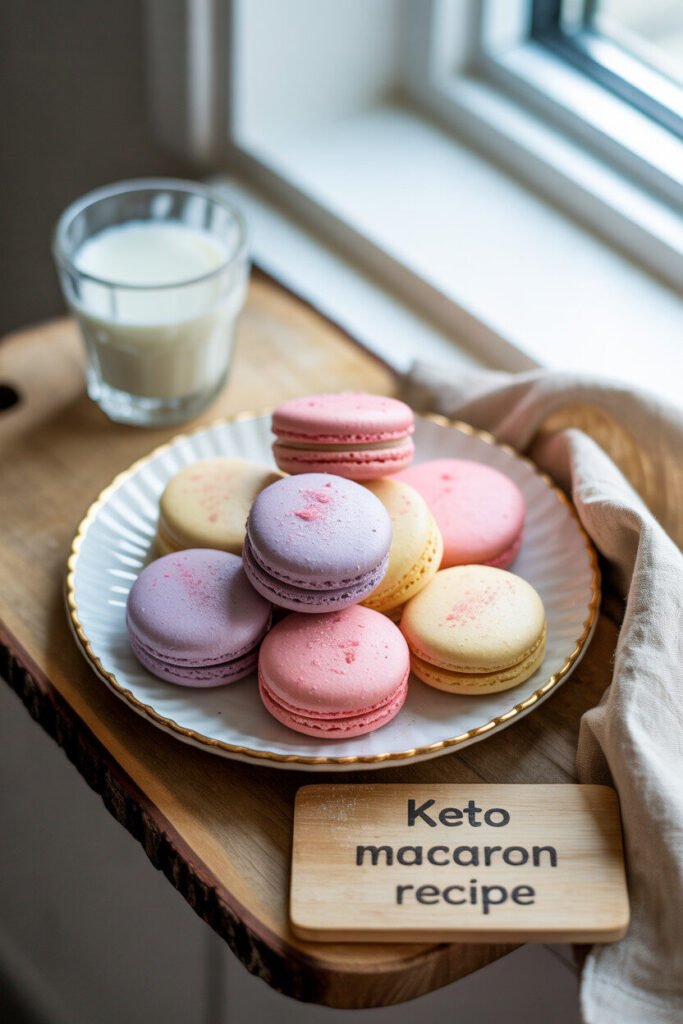Let’s be real—when I first heard about keto macarons, I was deeply skeptical. I’ve spent years perfecting traditional French macarons in my professional kitchen, and the idea of replacing powdered sugar and almond flour felt… well, sacrilegious. But after extensive testing (and I mean extensive—we’re talking dozens of batches that ended up in the compost), I’ve cracked the code.
The truth is, most keto macaron recipes online are frankly terrible. They produce flat, chewy, or hollow shells that bear little resemblance to the delicate treats we know and love. But when you understand the science behind both macaron-making and keto ingredient behavior, you can create something truly spectacular.
Why Traditional Macarons Don’t Work on Keto
The Problem with Almond Flour in Classic Recipes
Here’s the dirty little secret nobody talks about: standard almond flour is actually too coarse for proper macaron shells. Even the “super-fine” stuff contains enough larger particles to disrupt that signature smooth surface. In traditional recipes, the powdered sugar helps fill those gaps—but we can’t use that, obviously.
What’s more frustrating? Almond flour’s protein and fat content varies wildly between brands. I’ve tested this extensively with Blue Diamond, Bob’s Red Mill, and several specialty brands—the difference in moisture content alone can make or break your batch. And when you’re working with delicate meringue, that variability is your enemy.
The Sugar Conundrum: Meringue and Filling Challenges
Sugar does three critical things in traditional macarons: it stabilizes the meringue, creates the signature foot, and provides structure through crystallization. Remove it, and you’re left with a fragile ecosystem that collapses if you look at it wrong.
The stabilization piece is what most home bakers underestimate. Sugar syrup cooked to 118°C creates that glossy, stiff Italian meringue that can withstand folding. Without it, you’re relying entirely on egg white proteins—and let me tell you, they’re fickle partners. I’ve found that most keto sweeteners simply don’t provide the same structural integrity, which is why my method uses a specific combination.
The Keto Macaron Blueprint: Ingredients and Equipment
Specialized Keto Ingredients You’ll Need
After testing probably thirty different combinations, here’s what actually works:
- Almond flour replacement: You’ll need ultra-fine blanched almond flour (I specifically use Blue Diamond for consistency) BUT you must process it further with your keto sweetener. The particle size matters more than you’d think.
- The sweetener trio: Allulose powder (for the meringue), erythritol powder (for structure), and just a touch of monk fruit (for sweetness without cooling effect). This isn’t arbitrary—each serves a specific chemical purpose that replicates sugar’s functions.
- Egg white powders: Not liquid egg whites, but the powdered form. This is non-negotiable for me now—it provides additional protein structure that compensates for what we lose without sugar.
- Cream of tartar: Most recipes treat this as optional. In keto macarons, it’s essential for stabilizing your weaker meringue.
Essential Tools for Macaron Success
You can’t wing this with makeshift equipment. I’m serious—I’ve tried.
- Digital scale: Measuring cups are useless here. You need precision to 0.1 grams for consistent results.
- Silicone macaron mats: Parchment works, but the silicone mats with guides help maintain consistent size and spacing.
- Food processor: For that critical step of grinding your almond flour with sweetener to achieve the right particle size.
- Infrared thermometer: Your oven’s temperature display lies. Mine is consistently 15°F off, which is enough to ruin everything.
- Sieve or sifter: You’ll be sifting multiple times. Yes, it’s tedious. No, you can’t skip it.

Keto Macaron Recipe: Ingredients List
For the shells:
- 100g ultra-fine blanched almond flour
- 100g powdered erythritol/allulose blend (75/25 ratio)
- 90g egg whites (aged 24 hours at room temperature)
- ¼ tsp cream of tartar
- 1g salt
- 2g egg white powder
For the filling:
- 115g unsalted butter, softened
- 60g powdered erythritol
- 2 tbsp heavy cream
- 1 tsp vanilla extract or other flavoring
The Professional Method: Crafting Perfect Keto Macarons
Mastering the Keto Meringue
This is where most people fail. With traditional macarons, you have sugar creating a protective barrier around air bubbles. Without it, you need to be much more gentle and strategic.
Start with room temperature egg whites—I mean truly room temperature, not just out of the fridge for an hour. Cold egg whites won’t achieve the same volume. Add cream of tartar before you begin whipping, not after they’re frothy. And when you’re incorporating your sweetener, do it gradually—like one tablespoon every 30 seconds—while the mixer is on medium speed, not high.
The peak test is different too. With keto meringue, you want stiff peaks that stand straight up, but they should still look glossy and smooth. If they’re looking grainy or separated, you’ve overwhipped—and unfortunately, there’s no coming back from that. Start over.
Macaronage Technique with Low-Carb Flours
The macaronage (that’s the folding process) requires more finesse with keto ingredients. Your dry ingredients are inherently more absorbent, so they’ll suck moisture from your meringue faster.
I use the “figure-eight” test, but with a modification: the ribbon should hold its shape for about 8-10 seconds before melting back into itself. With traditional macarons, you’d aim for 5-7 seconds, but keto batter needs to be slightly thicker to account for the weaker structure.
Here’s a pro tip I learned the hard way: if your batter starts looking oily or separated, you’ve overmixed. The fats from the almond flour are leaching out, and your shells will be greasy and flat. At this point, honestly, it’s better to start fresh than to continue.
Baking and Troubleshooting Your Shells
Oven temperature is everything. I bake at 300°F (confirmed with my infrared thermometer) for 14-16 minutes, but I rotate the pans halfway through. The telltale sign they’re done isn’t color—it’s whether they release cleanly from the mat.
If they stick, they need another minute. If they’re browning, your oven runs hot. If they’re cracking, you likely didn’t let them rest long enough before baking (30-45 minutes is ideal for keto versions).
The feet—those ruffled bottoms—might be slightly smaller than traditional macarons, but they should still be present and even. If one side has higher feet than the other, your oven has hot spots. Rotate more frequently next time.
Advanced Keto Fillings and Flavor Combinations
Sugar-Free Buttercream and Ganache
American buttercream with just butter and powdered sweetener is… well, it’s gritty and overly sweet. Instead, I make an Italian meringue buttercream using allulose syrup. The cooking process dissolves the sweetener completely, giving you that silky texture you’re after.
For ganache, the type of chocolate matters enormously. Sugar-free chocolate chips often contain maltitol, which can cause digestive issues and doesn’t melt well. I prefer baking chocolate sweetened with stevia or monk fruit—Lily’s is my go-to for consistency.
The ratio is different too: 2:1 chocolate to heavy cream, rather than the traditional 1:1. Keto chocolate sets softer, so you need more of it to achieve the right piping consistency.
Creative Flavor Pairings for the Keto Palette
Since our taste buds are adjusted to less sweetness, you can play with more sophisticated flavors:
- Toasted coconut shells with dark chocolate ganache
- Lemon zest in the shells with blueberry buttercream (using freeze-dried berry powder)
- Matcha shells with white chocolate peppermint filling
- Espresso shells with salted caramel buttercream
The key is using high-quality extracts and natural flavorings. Artificial flavors can taste chemical-y when you’re not masking them with sugar.
Frequently Asked Questions
Can I use liquid sweeteners instead of powdered erythritol for keto macarons?
No, and this is crucial—liquid sweeteners will throw off your moisture balance and prevent the meringue from forming properly. The powder form is essential both for dissolving properly and for creating the right texture in the finished shells. If you can’t find powdered erythritol, you can pulse granular in a clean coffee grinder until it’s super fine.
Why did my keto macarons turn out hollow?
Hollow shells usually mean one of three things: undermixed batter, overmixed meringue, or oven temperature too high. With keto versions, I find overmixed meringue is the most common culprit—without sugar’s stabilizing effect, it’s easy to knock out too many air bubbles. Try whipping on medium speed rather than high, and add your sweetener more gradually.
How do I store keto macarons and how long do they last?
They keep surprisingly well—up to 5 days in an airtight container in the refrigerator, or you can freeze them for up to 3 months. The texture actually improves after 24 hours as the shells absorb moisture from the filling and become chewier. Just bring them to room temperature before serving.
Can I make these keto macarons nut-free?
You can try sunflower seed flour, but you’ll need to add 1 teaspoon of lemon juice to the flour to prevent it from turning green (a chemical reaction with the chlorophyll). Honestly though, the results are inconsistent. For truly nut-free, I’d recommend exploring other keto cookies instead—macarons really need that specific fat and protein structure from nuts.
Why is my keto macaron batter too runny?
Runny batter typically means either overmixing during macaronage, meringue that wasn’t stiff enough to begin with, or ingredients that were too warm. Make sure your egg whites are at peak stiffness before folding, and work in a cool kitchen—keto batters are more temperature-sensitive than traditional ones.
How many net carbs are in one keto macaron?
Depending on the size and specific ingredients, each shell contains about 0.5-1g net carbs. With filling, a complete macaron typically ranges from 1-2g net carbs each. Compare that to traditional macarons at 15-20g net carbs each, and the difference is substantial.
My keto macarons are too chewy. What went wrong?
Chewiness usually means overbaking or oven temperature that’s too low. The shells continue to dry out after baking, so it’s better to slightly underbake than overbake. Try reducing your oven temperature by 5-10 degrees and checking them a minute earlier—they should release cleanly but still feel slightly soft.
Can I flavor the shells of my keto macarons?
Yes, but be careful with liquid flavorings—they can destabilize your meringue. Powdered flavors work best: matcha, freeze-dried fruit powders, cocoa powder (replace 10g of almond flour with 10g cocoa), or spice powders. For extracts, use no more than ¼ teaspoon and add them to your egg whites before whipping.
🔥 The Keto Market is on fire! This best-selling Keto Bread brings back what people miss most – soft, delicious bread without the carbs! Finally, enjoy your favorite comfort food and stay 100% Keto-friendly.
Andreas – Keto recipe creator who lost 40lbs and discovered his love for low-carb cooking. 300+ tested recipes | 5 years of keto experience | Real food for real people. No certifications, just results that taste amazing!
